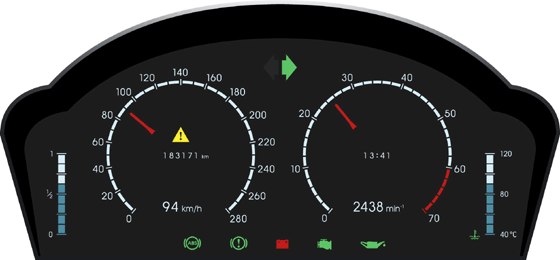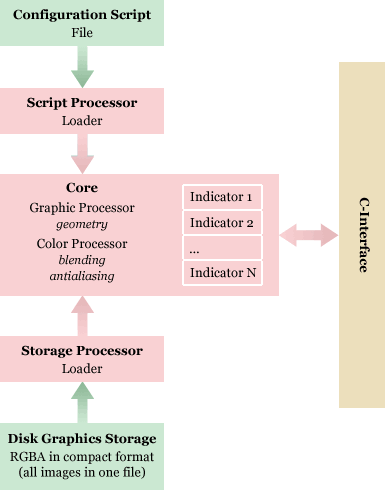Article 14
EGE — embedded graphics engine

1. Introduction to EGE
EGE stands for embedded graphics engine. The graphics engine is an effective solution for automotive and industrial embedded devices where graphics performance and
quality at low cost is essential requirement.
The core of the engine is smart mathematics that allows to build smooth and semitransparent graphics of RGBA format with minimal processor time consumption.
The engine itself is represented by a set of modules, everyone of which shaped for effective performance in predefined graphic operations.
EGE is written in C++ and implemented as standalone cross-platform library that does not need any additional modules or even OS.
2. Usage example — automotive digital LCD dashboard
The core idea behind EGE is thorough speed optimization for fast graphics rendering and high performance. As result of optimization the refresh rate of 50 Hz is easily achievable
for graphics boards of medium complexity without using of hardware acceleration. In the picture below — fig. 1 — you can see an
automotive digital dashboard prototype with the following characteristics:
| Digital dashboard prototype data |
|---|
| Processor | Intel XScale at 400 MHz |
| Hardware acceleration | None |
| RAM usage | 8 Mb |
| Space on disc | 300 Kb (engine + graphics) |
| Refresh rate | 50 Hz |
| Graphics format | RGB 16 bit |
| Buffering | Double |
| Number of indicators | 12 |
 Fig. 1. EGE engine rendering automotive digital dashboard graphics.
Fig. 1. EGE engine rendering automotive digital dashboard graphics.
3. EGE engine structure
EGE engine consists of the following modules — fig. 2:
- Core;
- Indicators;
- Script processor;
- EGF storage processor.
Core is responsible for fast graphics rendering that includes building pixel regions and lines, blending colors, rotating bitmaps and antialiasing.
Indicators contain displaying and speed-up logic for gauges of predefined type. All RGBA bitmaps for a board can be stored in a common file. As option only pixels with
nonzero alpha-channel can be stored so that the final size of the graphics storage is quite small. Thus, there a storage processor is present in the library that is responsible
for loading bitmaps from the storage. To position and define indicators properties there will be included a configuration script processor. The script itself is intended
to be represented by INI-like text file. Library functionality is intended to be exposed to the user through OpenGL-like C interface.
 Fig. 2. EGE graphics engine structure.
Fig. 2. EGE graphics engine structure.
5. To learn more
Details on our service for automotive industry:

|
- 2D and 3D graphics
- GUI
- peripheral drivers
- communication protocols
- RTOS
|
|

 Fig. 1. EGE engine rendering automotive digital dashboard graphics.
Fig. 1. EGE engine rendering automotive digital dashboard graphics.
 Fig. 2. EGE graphics engine structure.
Fig. 2. EGE graphics engine structure.



